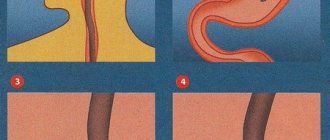Abdominal syndrome is one of the most important and common clinical manifestations of most diseases of the gastrointestinal tract. But unlike many other pathologies, it is impossible to “get sick” in the usual sense of the word. After all, abdominal syndrome is actually the pain that we feel. It can be different (for details, see the corresponding section): sharp, dull, pulling, cramping, encircling and point-like. Unfortunately, pain cannot be considered an objective criterion. Therefore, the attending physician often faces the need not only to explain the reasons for its occurrence, but also to alleviate the patient’s condition in the absence of a confirmed diagnosis.
However, in addition to the obvious difficulties associated with subjective sensations, abdominal syndrome (AS) differs from other similar conditions due to its confusing and difficult to understand classification. Firstly, the justification of such a diagnosis for any acute conditions (appendicitis, perforation of an ulcer, an attack of cholecystitis) is quite doubtful. Secondly, it should be clearly understood: AS, which we will talk about today, is not at all the same as abdominal ischemic syndrome (AIS, chronic abdominal ischemia syndrome). After all, AIS is a long-term, chronic insufficiency of blood supply in various parts of the abdominal aorta. Thirdly, many domestic doctors treat AS with some prejudice, not considering it an independent nosological entity. The main argument is the interpretation of the patient’s subjective complaints, because many of them (especially if the question concerns children) are unable to explain in words what worries them. And “concerned” mothers, demanding (!) to diagnose their child with “abdominal syndrome” if he has eaten too much candy or unripe apples, are unlikely to cause a surge of positive emotions in the doctor.
The topic “ARVI and abdominal pain syndrome in children” deserves special mention. What could be the connection between an acute respiratory viral infection and pain caused by pathology of the gastrointestinal tract, you ask? To be honest, we ourselves did not immediately understand this. But after digging through specialized forums, we found out that such a diagnosis is very popular in our area. Formally, he has the right to life, but most practicing doctors who take their work responsibly are confident that in this case, district pediatricians are trying to avoid mentioning acute intestinal infection (AEI) in the medical record. It is also possible that such “ARVI” means hidden appendicitis. “Treatment” will, of course, give results. The patient will most likely stop coughing, but will very soon end up on the operating table.
What is abdominal pain
Abdominal pain is not an independent disease. They indicate any pathological processes occurring in the peritoneal cavity. The abdomen is bounded above by the costal arches, and below by the symphysis pubis. When pathological processes occur, unpleasant sensations can radiate to these areas. This complicates the process of establishing the exact cause of the symptom complex. Therefore, for diagnosis it is necessary to use several examination methods.
Acute abdominal pain occurs with vascular pathologies or diseases of the peritoneum. For example, vascular thrombosis, bleeding, rupture of the spleen and intestinal pathologies.
Any discomfort in the abdominal area can be regarded as abdominal pain syndrome.
Dangerous symptoms
What symptoms are the most dangerous for abdominal pain? Let us briefly list the signs hinting at emergency surgery:
- tachycardia;
- arterial hypotension;
- weakness;
- apathy;
- dizziness;
- fever;
- visible bleeding;
- repeated vomiting;
- absence of peristaltic noise and gas discharge;
- increase in abdominal volume;
- muscle tension in the abdominal wall;
- increased pain syndrome;
- fainting during bowel movements;
- Shchetkin-Blumberg symptom (positive).
Types of pain and their characteristic signs
According to the mechanism by which sensations arise, there are several types.
Visceral pain. Occurs in a parenchymal or hollow organ. May be associated with injury, overextension, inflammation, or problems in the circulatory system. Visceral type pain is observed in organic or functional conditions. In this case, signs of nausea, stool retention, and vomiting occur. Other symptoms include fever and bloating.
Sharp sensations can be accompanied by autonomic disorders. The person experiences fear, rapid heartbeat, sweating, dizziness and pallor.
Somatic pain. It is also called parietal. Such sensations occur when the abdominal cavity is irritated. Sometimes it begins with inflammation in the internal organs, then the layers of the peritoneum are involved in the process. The pain increases and becomes localized. The sensations intensify.
Radiating pain. Similar sensations occur in an area of high sensitivity of the skin, the innervation of which is carried out by the same section in the spinal cord as the affected organ.
Psychogenic pain. Occurs if the functioning of the central mechanisms for controlling pain sensitivity is disrupted. Organic pathological processes do not occur in the peritoneum. The sensations are long-lasting, constant, without exacerbations.
Classification
Abdominal pain can be divided into two main types:
- short-lived, but characterized by rapid development;
- chronic, which progress gradually as the condition worsens.
«>
In addition, there is another classification of syndromes according to the type of appearance. The following are distinguished:
- Visceral. Abdominal syndrome is formed as a result of tension, which contributes to irritation of the receptors. This type of pain is characterized by an increase in pressure inside the organ due to tension in the walls.
- Parietal. Here the nerve endings come to the fore. This deviation occurs as a result of damage to the abdominal walls.
- Reflected. This is more of a subtype of visceral pain. If it passes with great tension, it develops into a reflected one.
- Psychogenic. The development of the syndrome in this case occurs secretly. Usually this type of pain occurs due to depression. Often the patient does not even realize there is a problem, as he simply does not notice it. Abdominal pain is accompanied by other unpleasant sensations in the back or head.
Causes of pain
Main causes of pain:
- Extra-abdominal. For myocardial infarction, pleurisy, pneumonia, anemia, endocrine and hormonal disorders, as well as osteochondrosis. Most of these painful sensations are referred.
- Intra-abdominal. These sensations indicate that an inflammatory process is occurring in the human body, spastic sensations, stretching, and problems with blood circulation are observed. Such sensations also occur with growths in the peritoneal cavity. Visceral pain may be due to stomach disease.
The causes of unpleasant sensations can be pathological or non-pathological processes.
Non-pathological include:
- Wrong diet. For example, there are too many spicy foods and carbohydrates in the diet.
- Taking medications. Some tablets have a negative effect on gastrointestinal motility and mucous membranes.
- Menstruation. Systematic pain is caused by temporary endometrial ischemia and myometrial spasm.
- Unpleasant sensations in the stomach in children. Up to a year, the sensations are due to the immaturity of the digestive system. Up to 3 years of age, processes of a psychological nature or pathology develop due to errors in the diet.
- Pain during pregnancy. Caused by sprained ligaments, divergence of the symphysis pubis, joint surfaces, or tension of the skin.
Pathological factors:
- colitis, endometritis, pancreatitis, cholecystitis and other inflammatory pathologies;
- bleeding in the stomach or intestines, pathologies of the kidneys, spleen, ovaries, ischemia;
- stones in the ureter, esophageal stenosis, intestinal obstruction and other obstructive phenomena;
- ulcerative, erosive processes, traumatic changes in organs and necrotic transformations;
- oncology.
Classification
The presence of abdominal pain requires in-depth diagnosis and subsequent treatment. The classification system for the mentioned syndrome is quite complex.
Pathogenetic classification
- Spasmodic pain. Colloquially known as colic. The cause is a spasm of smooth muscles. They arise from organic abdominal pathologies (renal, gastric, liver, pancreatic), functional ailments (irritable bowel syndrome) and poisoning. Spastic pains flare up unexpectedly and can stop just as suddenly. The syndrome can be alleviated with antispastic drugs and heat. Concomitant symptoms sometimes include flatulence, vomiting, cardiac arrhythmia, and problems with coronary circulation.
- Pain associated with stretching of hollow organs. There is no clear localization, the character is pulling and cutting.
- A syndrome caused by problems of local circulation. There are two types: angiospastic (attacks) and stenotic (proceed slowly, but can become increasingly severe).
- Peritoneal pain. They are characterized by suddenness, duration and gradual subsidence. The localization is clear, the doctor can identify it through palpation. Mechanical impact (movement, coughing, palpation) may increase the degree of pain.
- Reflected syndrome. Abdominal pain that flares up in the digestive organs can radiate to the stomach.
Mechanism of occurrence
- Visceral syndrome. It is greatly facilitated by pathological processes occurring in the internal organs. The starting point can be, say, an increase in pressure in the cavity of the organ, as well as tension, stretching and vascular disorders in the abdomen.
- Somatic pain. They occur if the abdominal wall and the peritoneum itself are involved in the pathological process. They are clearly localized and acute in nature. It gets worse when coughing and moving.
- Referred pain. With visceral syndrome (passage of a stone), the impulse can radiate to the abdomen. The syndrome may also be based on an anatomical cause (strangulation of the intestine). Sometimes the pain radiates to the back, shoulder or right shoulder blade.
- Psychogenic syndrome. If there are no somatic and visceral causes, the triggering factor may be psychogenic. Depression plays a key role here. Abdominal pain is associated with depression through complex biochemical processes. The main features: monotony, duration and diffuse qualities. At the same time, pain may be felt in the back, head and throughout the body.
Localization
Depending on the damage to a particular organ, different parts of the abdomen may hurt.
- Right hypochondrium. Signals about ailments in the gall bladder, liver, duodenum, biliary tract, pleura, right lung, head of the pancreas.
- Left hypochondrium. Problems in the stomach, spleen, pancreas, ureter, left kidney, pleura and left lung.
- Epigastrium. The disease is rooted in the bile ducts, liver, pancreas, lower esophagus, stomach, chest, celiac plexus.
- Right iliac region. The pathology crept into the ileum (terminal section), appendix, ureter, right kidney, right appendages of the uterus (in women).
- Left iliac region. The problem is in the colon, ureter, left kidney and left uterine appendages.
- Periumbilical part. The colon or small intestine (transverse), appendix, abdominal vessels or pancreas are affected.
- Groin and pubis. The violations affected the female genital organs, bladder, and rectum.
Etiological classification
This classification includes the main symptoms of abdominal pain.
Intra-abdominal causes
- inflammation of organs (cholecystitis, appendicitis, peptic ulcer, etc.);
- generalized peritonitis (primary and secondary);
- obstruction of a hollow organ (biliary, intestinal, urinary tract, aorta, uterine);
- ischemic disorders (organ torsion, intestinal infarction, etc.);
- others (retroperitoneal tumors, drug withdrawal, hysteria, hemolytic anemia).
Extra-abdominal causes
They mean radiating pain not in the abdomen - formed by pathologies of other organs. These include:
- pathologies of the thoracic cavity organs (myocardial ischemia, pneumonia, pneumothorax, diseases of the esophagus, pleurisy);
- neurogenic diseases (syphilis, spinal diseases, polyneuritis);
- exposure to toxins (poisons, insect bites);
- metabolic disorders (diabetes mellitus, for example).
"Non-surgical" reasons
It also happens that abdominal syndrome is of a non-surgical nature. The reasons lie in the area of the following systems:
- cardiovascular;
- respiratory organs;
- digestive organs;
- urogenital;
- hematopoietic;
- diseases of the musculoskeletal system;
- infectious diseases;
- endocrine and metabolic disorders.
Development speed
Depending on the progression, the syndrome in question is divided into:
- acute form;
- chronic form.
When to see a doctor and diagnosis of the causes of pain
You should contact specialists in the following cases:
- Increased discomfort in the abdomen. Abdominal pain syndrome is accompanied by tachycardia, dizziness, weakness throughout the body, a sharp decrease in pressure, blood in the stool or vomiting.
- Viral or bacterial infection. In this case, discomfort occurs along with chills, fever, and diarrhea.
- Acute abdominal discomfort, in which the patient is forced to look for the most comfortable position. Accompanied by stool retention and may be life-threatening.
- Local or widespread peritonitis. Characterized by tension in the abdominal muscles.
It is not always possible to determine the source of pain. This makes it difficult to find out the exact cause. Examination data and patient complaints are not enough; diagnostics are required, especially if the symptom is chronic.
Sometimes laboratory and instrumental diagnostic methods are required:
- general urine and blood tests, biochemistry with the detection of enzymes, trace elements, hormones;
- Ultrasound of the pelvic organs and peritoneum is necessary to determine the condition of the internal organs, their size, shape, and whether there are any neoplasms or pathological processes;
- CT and MRI help to clarify how far the pathological process has spread and whether tumor metastases have occurred;
- X-rays help to determine whether there are foreign bodies in the hollow organs, the state of the blood flow, check the patency of the intestines, the presence or absence of fluid and gas in the peritoneum.
Clinical picture
The symptomatic pattern of abdominal syndrome, in addition to the fundamental indicator (abdominal pain), is complemented by other negative manifestations that signal the presence of pathologies of various natures.
- sweating
- nausea
- rapid pulse
- chills, fever
- leukocytosis
- food refusal
- change in urine color
Alarm signals that increase the need to promptly diagnose the problem and begin treatment.
- my stomach hurts for more than two hours, the intensity increases
- temperature rises sharply
- vomit
- bleeding
- bradycardia
- low blood pressure
- rapid pulse
- secondary vomiting
- muscle hypertonicity
- atypical increase in size
- sharp weakening or complete disappearance of peristaltic sounds
Abdominal pain “accompanies” a number of diseases, some of which are acute and require urgent help
Appendicitis is a sudden pain that initially affects the peri-umbilical area, then spreads throughout the entire abdominal area. After a few hours, the localization becomes more specific, most often on the right side of the lower abdomen. Combined with tachycardia, bluish skin, drop in blood pressure, vomiting, muscle hypertonicity.
Perforation of an ulcer—the pain is acute, excruciating, and grows rapidly. Accompanied by a sharp tension in the abdomen, which becomes hard. The attack is characterized by consistency and high intensity. The first hours of pain are so sharp, as if the stomach was struck by a dagger. The skin is pale, sweats, breathing is difficult, and the pulse slows down.
The initial concentration is the epigastric region, right hypochondrium. Then, with a free perforation, the entire abdomen is negatively affected and becomes retracted.
The pain subsides after six hours, accompanying symptoms:
- temperature jump
- dry tongue
- flatulence
- constipation
- Blood pressure decreases, heart sounds are muffled
- heart rate increases
Treatment starting 10-14 hours after perforation is complicated, since at this stage the clinical indicators of peritonitis increase. For such a situation, the primary aid measures are clear - rest, horizontal position, no eating, no drinking, a categorical ban on analgesics, immediately call 03.
Attack of pancreatitis
The catalysts for the onset of an attack are dysfunctions of the organs involved in the digestive process, primarily pathologies of the liver and bile ducts.
The list of etiological factors for pancreatic inflammation will be supplemented by excessive “infatuation” with fried, fatty foods.
Alcohol abuse and allergic reactions aggravate the situation. It occurs unexpectedly, is characterized by increased intensity, can last a whole day, periodically weakening, but does not completely disappear.
Irradiation to the heart, left shoulder blade. The negative background of such pain is:
- incessant vomiting, and it doesn’t get any better
- yellowing of the sclera
- loose stool
The attack “starts” suddenly, characterized by dagger-like pains, initially localized in the lower back, from the side of the affected kidney, then radiating to the perineum and groin.
Signs
The clinical picture is in many ways identical to the symptoms of an “acute abdomen”; restless behavior and sudden completion are characteristic features of such an acute condition.
Intestinal obstruction
The motor-evacuation function is “damaged,” the pain is severe, occurs unexpectedly, lasts a long time, and is intense in nature.
Abdominal pain is a fundamental diagnostic criterion for acute intestinal obstruction
In the later stages, the likelihood of diffuse peritonitis increases, burning pain is felt in all quadrants of the abdomen, constipation and flatulence are a concern.
Hepatic colic
The pain is sharp, spontaneous, rapidly growing, and can last up to a day. They arise in the right hypochondrium, the right collarbone and scapula feel the negative consequences. The attack is accompanied by vomiting bile, the skin turns yellow, and the state is excited.
Diagnosis
An accurate assessment of the nature of abdominal pain is a difficult task for a doctor; a correct assessment of the current condition is an extremely important decision, sometimes capable of saving the patient’s life.
Such manifestations are a basic signal of the possible presence of an “acute abdomen,” but on the other hand, painful discomfort in the abdomen is possible against the background of other pathologies that do not require urgent surgery.
To suggest the possible etiology of abdominal pain, special attention is paid to the qualitative collection of anamnestic information. The patient's intensity, location, attitude to food intake, and the nature of the sensations disturbing the abdomen are determined.
The identified cause will directly affect further treatment tactics.
Stages of visual inspection:
- History taking
- Determining your preferred position
- Palpation procedure
- Auscultation of the abdomen
- Record the patient’s behavior (relaxed, lies quietly, or rushes about, moans, screams)
- Percussion helps determine the likelihood of perforation of the hollow abdominal organs
List of standard prescribed examinations:
- Ultrasound, CT, x-ray of the abdominal area
- blood tests (detailed, biochemical), urine tests
- liver function tests
- x-ray of the spine
- FGDS
- cardiogram
First aid
Forbidden
- Self-medication, especially with severe pain discomfort
- Taking analgesics is strictly unacceptable
Taking painkillers will make the situation worse, making it difficult for doctors to diagnose the problem in a timely manner. The consequences of such independence are negative and dangerous complications are likely.
Treatment of pain conditions
Therapy is carried out to relieve inflammation and suppress infection, if established. Treatment helps reduce swelling, improve blood circulation and restore the functioning of damaged cells. These are the basic principles of treatment. They use antibiotics, antispasmodics, choleretic drugs, homeopathic remedies and other medicines.
The doctor prescribes a diet that is designed to reduce the load on the internal organ and relieve irritation, eliminating cramping pain. For example, the specialist recommends stopping consuming too hot or cold foods, fatty foods, sweets, caffeine and carbonated drinks.
The most dangerous symptoms
The general signs of the disease were discussed above; if they appear, you just need to see a doctor. However, abdominal pain syndrome is characterized by the fact that sometimes its manifestations require emergency surgical intervention. Alarming symptoms:
- increased heart rate (tachycardia);
- apathy, indifference;
- severe dizziness;
- repeated vomiting;
- fainting;
- the pain intensifies several times;
- bleeding.
If such signs are detected, in no case should they be ignored, citing the fact that “they will go away on their own.” This is already a serious stage of the disease, and only a specialist can help in this situation.
Human abdomen
To make it easier to understand the question: “Abdominal syndrome - what is it?”
and to understand where it comes from, you need to clearly understand how our stomach works, what organs it contains, how they interact with each other. In anatomical pictures you can see a schematic tube of the esophagus, a baggy stomach, an intestine wriggling like a snake, the liver on the right under the ribs, the spleen on the left, and at the very bottom the bladder with ureters extending from the kidneys. That, it seems, is all. In reality, our abdominal cavity has a more complex structure. Conventionally, it is divided into three segments. The border of the upper one is - on one side - a dome-shaped muscle called the diaphragm. Above it is the chest cavity with the lungs. On the other hand, the upper segment is separated from the middle by the so-called mesentery of the colon.
This is a two-layer fold, with the help of which all organs of the gastrointestinal tract are attached to the posterior plane of the abdomen. In the upper segment there are three sections - hepatic, pancreas and omental. The middle segment extends from the mesentery to the beginning of the pelvis. It is in this part of the abdomen that the umbilical zone is located. And finally, the lower segment is the pelvic area, in which the organs of the genitourinary and reproductive systems find their place.
Any disturbances (inflammation, infection, mechanical and chemical influences, pathologies of formation and development) in the activity of each organ located in the above three segments cause abdominal syndrome. In addition, the peritoneum contains blood and lymphatic vessels and
Among them, the most famous are the aorta and solar plexus. The slightest problem with them also provokes abdominal pain.
To summarize: abdominal syndrome can be caused by any currently known disease of the gastrointestinal tract and genitourinary system, problems with blood vessels and nerve plexuses of the peritoneum, chemical exposure (poisoning, drugs), mechanical compression (squeezing) by neighboring organs of everything located in the peritoneum.









